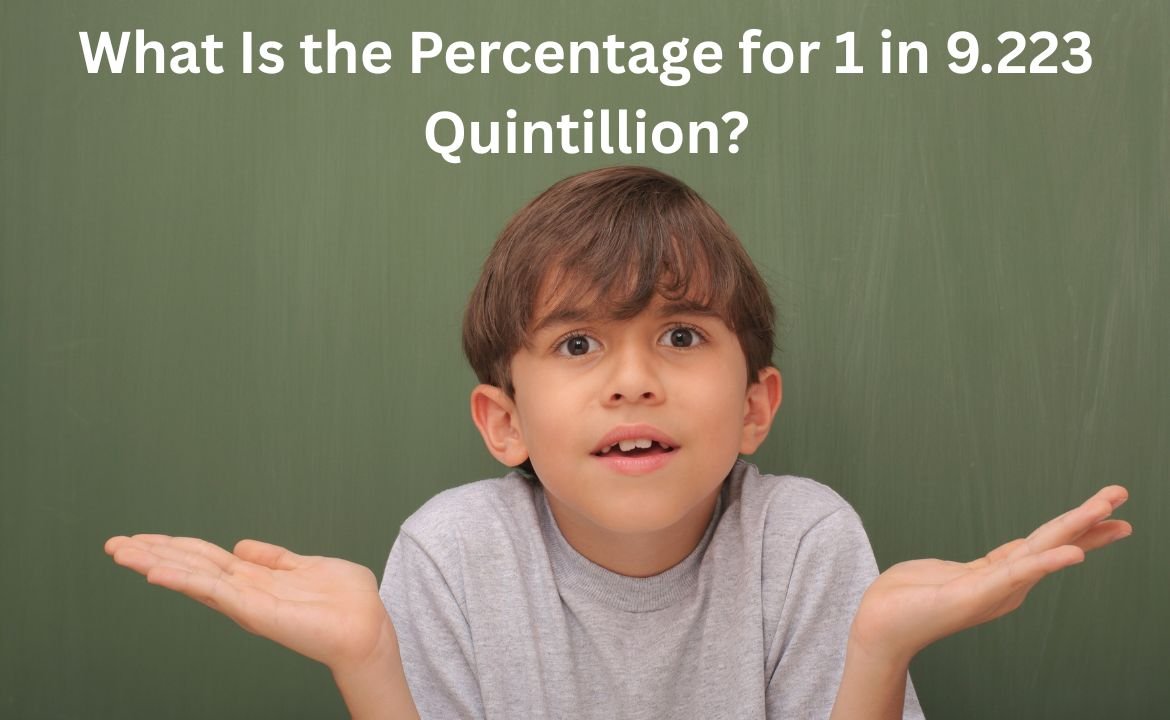If you’ve ever wondered what is the percentage for 1 in 9.223 quintillion, you’re not alone. This mind-blowingly large number often comes up in contexts like odds of winning lotteries or computing probabilities in large-scale data sets. Let’s break it down into simple math and explain why this number is so significant. Understanding the percentage for 1 in 9.223 quintillion is not just a mathematical exercise; it has real-world implications that can affect decision-making and risk assessment.
Understanding 9.223 Quintillion
What Does “Quintillion” Mean?
The scale of a quintillion can be both mind-boggling and fascinating. A quintillion is represented numerically as 1,000,000,000,000,000,000, which means it contains a staggering 18 zeros. To put this into perspective, when you hear the figure 9.223 quintillion, it translates to a colossal 9,223,000,000,000,000,000.
This immense number finds its significance in various fields such as computing—where it often represents the maximum integer value for 64-bit systems—probability theory, and even in astronomical calculations that deal with the vastness of space.
When considering what is the percentage for 1 in 9.223 quintillion, we step into a realm that highlights just how rare an event can be in such vast quantities. The calculation reveals that 1 is just a minuscule fraction of this immense total, equating to approximately 0.0000000000108 percent.
Simple Math: What Is the Percentage for 1 in 9.223 Quintillion?
To find out what percentage 1 represents in 9.223 quintillion, we can apply a straightforward formula. By dividing 1 by 9.223 quintillion, or 9,223,000,000,000,000,000, we get a minuscule number: approximately 1.084 × 10⁻¹⁹. This figure highlights just how rare or unique a single instance is within such an astronomically large total.
Now, to express this fraction as a percentage, we simply multiply the result by 100. This calculation yields about 1.084 × 10⁻¹⁷%, emphasizing that 1 in 9.223 quintillion is an incredibly small portion—almost negligible in the grand scheme of things.
This tiny percentage serves as a powerful reminder of the vastness of numbers and how our everyday experiences can often feel insignificant when viewed through the lens of such monumental scales.
Final Answer:
When exploring the question of what is the percentage for 1 in 9.223 quintillion, we uncover a figure that stretches the limits of comprehension. The percentage, roughly 0.00000000000000001084%, is so minuscule that it often feels like an exercise in futility to grasp its significance.
In practical terms, this value is effectively indistinguishable from zero in most everyday scenarios, leading us to ponder the implications of such tiny probabilities.
Why Is This Number Used?
1. In Computing
In the realm of computing, the staggering figure of 9.223 quintillion emerges as a crucial threshold within the framework of 64-bit architecture. Specifically, this number represents the maximum value for a signed 64-bit integer, calculated as 2⁶³ – 1, or 9,223,372,036,854,775,807.
A vast limit plays a pivotal role in software engineering, influencing how developers design applications and manage data. When working with large datasets or complex calculations, understanding this boundary ensures that programs run efficiently and without error.
2. In Probability and Statistics
When faced with odds as staggering as 1 in 9.223 quintillion, one cannot help but marvel at the implications these numbers carry across various fields. In cryptography, for instance, security levels often hinge on the complexity of keys; a probability this extreme suggests that breaking into a system is nearly unthinkable. This highlights the strength of modern encryption techniques, which rely on vast numerical spaces to ensure data protection.
Real-Life Context: Comparing the Odds
To put the staggering odds of 1 in 9.223 quintillion into perspective, consider the chances of winning the Powerball jackpot, which stand at about 1 in 292 million. This means you’re over 31 million times more likely to hit the lottery than to encounter the astronomical odds of that quintillion figure.
Getting struck by lightning during your lifetime, with odds of roughly 1 in 15,300. This statistic highlights just how frequent some rare occurrences can be when juxtaposed with those mind-boggling odds of 1 in 9.223 quintillion. In another realm of improbability, shuffling a deck of cards into a specific order yields odds of 1 in 8.0658 × 10⁶⁷, which, while also astronomically low, is still dwarfed by the quintillion figure.
These comparisons reveal not just numbers, but a fascinating perspective on chance and probability—reminding us that while some events feel impossibly rare, others are far more likely to occur in our everyday lives.
How to Visualize a Quintillion
Trying to understand such a huge number? Here’s a way to think about it:
While 1 million seconds equals roughly 11.5 days and 1 billion seconds stretches into 31.7 years, a quintillion seconds balloons to over 31 million years! This perspective highlights the sheer scale of such a number. Imagine trying to select just one specific moment from an unfathomable 9.223 quintillion options—that’s akin to finding a needle in an astronomical haystack.

Let’s break down what that means in terms of probability. The question, “What is the percentage for 1 in 9.223 quintillion?” reveals a mind-boggling reality: the odds are astronomically low. To put it in context, your chances are less than one in a billion of winning the lottery multiple times in a row! Such infinitesimal probabilities can make even the most optimistic gambler think twice.
Application in Technology and Security
This number isn’t just theoretical—it has practical uses:
In Cryptography
In the realm of cryptography, the security keys used in encryption are meticulously designed around extraordinarily large numerical values. For instance, when we consider numbers on the scale of 9.223 quintillion, the probability of randomly guessing a correct key becomes astronomically low.
If someone attempted to brute-force such a key, the time required would exceed the lifespan of the universe itself—an unfathomable duration that underscores the robustness of modern encryption techniques.
In Hash Functions
Hash functions play a pivotal role in modern technology and security, particularly when it comes to ensuring the integrity of data. By generating unique identifiers, such as UUIDs, they create a vast pool of possibilities that approaches 9.223 quintillion.
This immense scale significantly reduces the likelihood of duplicate or colliding entries within databases, allowing for seamless data management and retrieval.
How Accurate Is the Calculation?
While we rounded to 0.00000000000000001084%, let’s clarify:
- This is accurate to 5 decimal places in scientific notation.
- In decimal terms, it’s precise enough for theoretical math or conceptual use.
- But for scientific papers, you’d represent this with scientific notation like 1.084e-17%.
Conclusion: Understanding Beyond the Numbers
When someone asks what is the percentage for 1 in 9.223 quintillion, they’re stepping into the realm of theoretical possibility. While such odds are virtually zero, understanding how they’re calculated gives you better insight into data science, computing, and probability.
These calculations play a vital role in developing secure systems, creating reliable simulations, and ensuring the safety of technology we use every day. The next time you encounter a statistic of this magnitude, you’ll have a clearer perspective on its implications—and the improbability behind it. Embrace this knowledge to better appreciate the complexities of data and the science behind the numbers.
